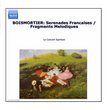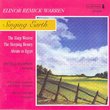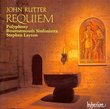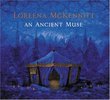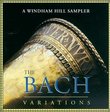| All Artists: Modest Mussorgsky, Valery Gergiev, Wiener Philharmoniker Title: Mussorgsky: Pictures at an Exhibition, Night on the Bare Mountain Members Wishing: 0 Total Copies: 0 Label: Philips Release Date: 5/14/2002 Genres: Dance & Electronic, Classical Styles: Opera & Classical Vocal, Forms & Genres, Theatrical, Incidental & Program Music, Symphonies Number of Discs: 1 SwapaCD Credits: 1 UPC: 028946852620 |
Search - Modest Mussorgsky, Valery Gergiev, Wiener Philharmoniker :: Mussorgsky: Pictures at an Exhibition, Night on the Bare Mountain
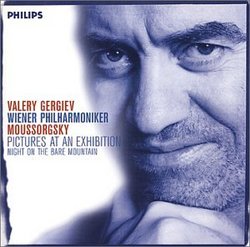 | Modest Mussorgsky, Valery Gergiev, Wiener Philharmoniker Mussorgsky: Pictures at an Exhibition, Night on the Bare Mountain Genres: Dance & Electronic, Classical
Valery Gergiev's absorbing traversal of Pictures at an Exhibition stresses composer Mussorgsky's elemental sensibility over Ravel's urbane orchestration. The conductor achieves this by encouraging the Vienna Philharmonic b... more » |
Larger Image |
CD DetailsSynopsis
Amazon.com Valery Gergiev's absorbing traversal of Pictures at an Exhibition stresses composer Mussorgsky's elemental sensibility over Ravel's urbane orchestration. The conductor achieves this by encouraging the Vienna Philharmonic brass to play up their characteristically broad sonority, especially from the elemental choralelike writing in Catacombae until the concluding Great Gate at Kiev's shattering climax. Some of the conductor's rubatos, however, seem grafted on rather than genuinely felt, like the arch clarinet ritard in Tuileries and the overphrased string legatos that bog down The Old Castle's basic pulse. Philips' spacious sonics convey a palpable concert hall ambience (this is, after all, a live recording), yet lack the dynamic impact and vivid detail one still hears from the benchmark Reiner and Szell editions. As a result, Night on the Bare Mountain's swirling momentum sounds diffused and dramatically flat. The Khovanshina Prelude and Gopak, though, make delightful fillers. --Jed Distler Similar CDs
Similarly Requested CDs
|
CD ReviewsAbsolutely Splendid! Grady Harp | Los Angeles, CA United States | 04/10/2004 (5 out of 5 stars) "Hearing Valery Gergiev conducting the Vienna Philharmonic in a live performance of Moussorgsky's PICTURES AT AN EXHIBITION has all the magic one could ever expect or want. Not only is Gergiev sensitive to the nuances in this Ravel orchestration of Moussorgsky's original work for piano, he manages to allow the individual 'images' along the promenade to breathe exactly the way an astute museum visitor might pause to absorb all the information in each painting. The breadth of the orchestral color here is captured with full range sonic technology, affirming the status of the Vienna Phil lush strings as being among the wonders of the music world. Individual solos are allowed to sing with the conductor collaborating: this orchestra must love playing for Gergiev! Some may quibble about tempo alterations in his interpretation, but to this listener those changes bring new vivid life to what was once a simple warhorse of early recording days. The accompanying works are well performed, especially the Prelude to Khovanshchina in Shostakovich's orchestration. This is a splendid addition to Gergiev's expanding recorded repertoire." Almost The Best Modern Recording Of "Pictures" John Kwok | New York, NY USA | 12/29/2002 (5 out of 5 stars) "Vaerly Gergiev leads the Vienna Philharmonic in an absorbing, dramatic performance of Mussorgsky's "Pictures at an Exhibition", using the familiar Ravel orchestration. He successfully urges the Vienna Philharmonic Orchestra to opt for a level of playing which transcends Ravel's almost conventional orchestration, emphasizing sonority, without forsaking either technical brilliance or a firm understanding the score. Yet I concur with Amazon.com's reviewer that Gergiev makes some questionable decisions with regards to tempo and emphasizing the string section's exquisite playing over the others. Personally, a more satisfying modern recording is the classic Deutsche Grammophon version with Sinopoli conducting the New York Philharmonic, since he doesn't emphasize abrupt changes in tempi as much as Gergiev. But I am certain fans of both Valery Gergiev and the Vienna Philharmonic won't be disappointed with this recording, which also features as excellent filler other works by Mussorgsky, most notably "Night On Bare Mountain"." Clear, enunciated, using a large palette of sound Kelly L. Norman | Plymouth, MI United States | 08/14/2006 (5 out of 5 stars) "This is a fine Exhibition. From the very first Promenade, the brass has greater clarity, the tempo is a bit faster, and one can sense there is something special afoot. In "Gnomus", "Il vechhio castello", "Tuileries" and "Bydio", the sound is so low and moving, so earthy, I am reminded of Stravinski's "The Rite of Spring".
As "Bydio" goes from mezzo forte to fortissimo, clarity isn't lost; the recording is faithful to each instrument, percussion, brass, strings. Gergiev is able to bring emotion out in each piece, while not being overly histrionic or clowning. "Ballet des poussins dans leurs coques" is lightly pleasant next to the stately mournful "Goldberg and Schmuyle", for example. The chef d'oeuvre, "The Great Gates of Kiev", shows an incredible range of timbre, something Gergiev excels at, with the booming fortissimos at the outset fading to pianissimos and growing again in the refrain to fortissimos. One can certainly envision oneself admiring the painting from bottom to top, sensing oneself as a tiny human being next to this awesome manmade wonder. "Khovanschina" is a proud part of Gergiev's repertoire, and he clearly enjoys presenting the lovely prelude here. Vienna, as usual, gives him what he wants. "Night on Bare Mountain" evokes a cold stormy night in a mountain forest. Effectively. Wear your parka. "Gopak" is sprite and merry. A wonderful dance tune; Gergiev and Vienna do it justice. Gergiev once mentioned how honored he was to have been asked to be a guest conductor for the Vienna Philharmonic, because the musicians in that orchestra choose their guest conductors. They seem to have chosen well in this case, and for Mossourgsky, it seems a good fit." |

 Track Listings (18) - Disc #1
Track Listings (18) - Disc #1